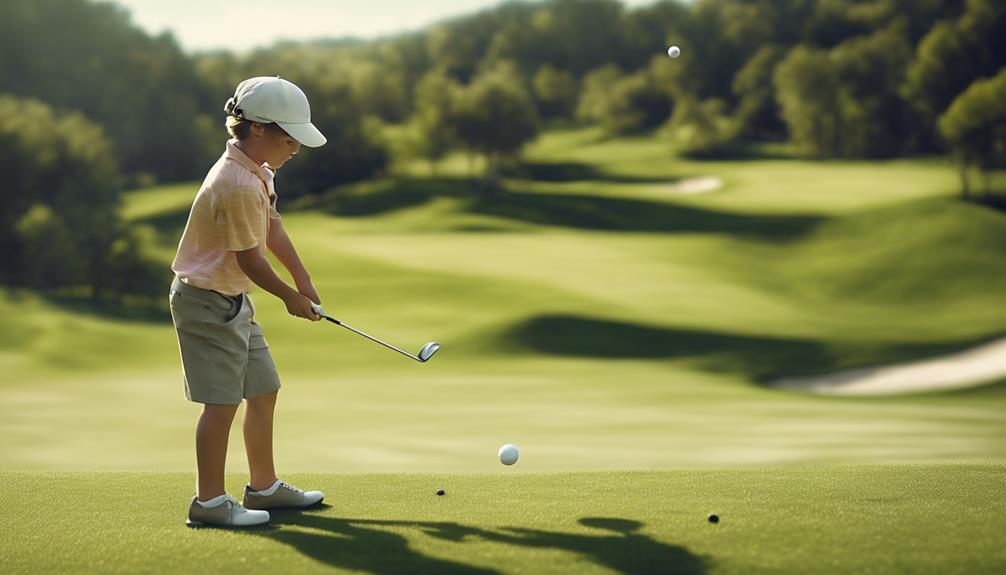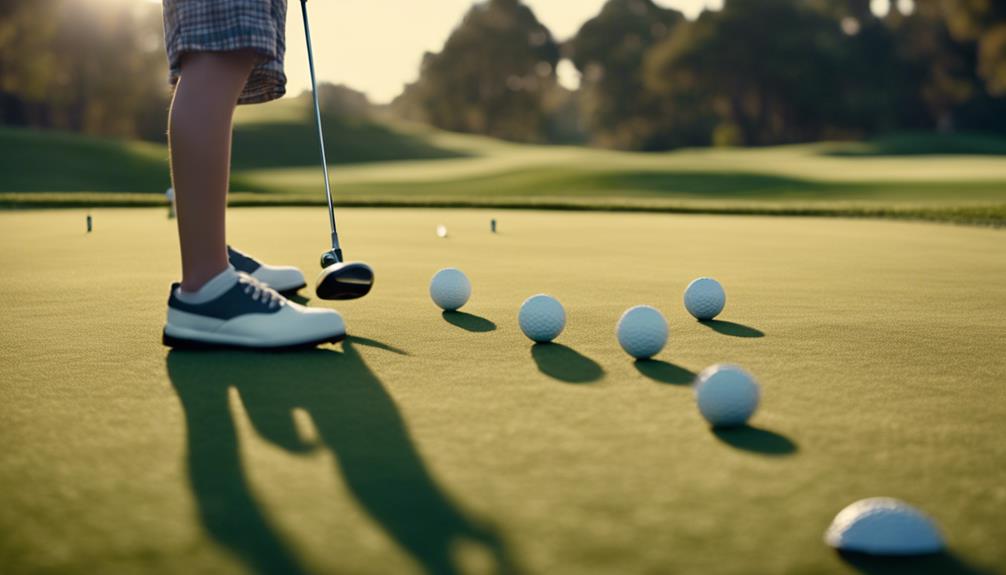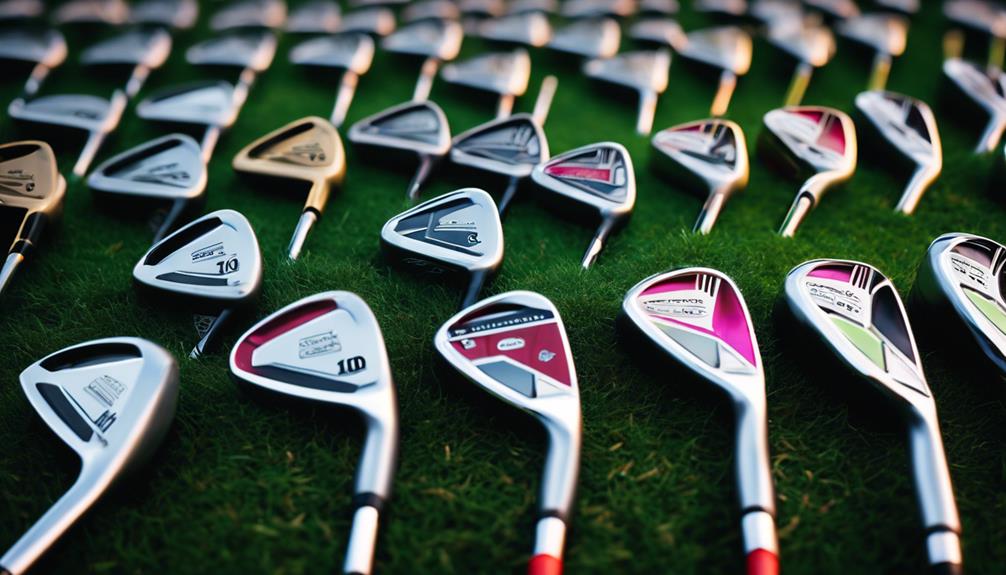- 7 Top Flite Golf Clubs XL for Improved Performance - September 28, 2024
- Top Flite Golf Clubs: Top 5 Reasons to Choose Them - September 28, 2024
- Top 3 Golf Club Fitters for a Perfect Swing - September 28, 2024
You'll need a mix of forgiving and precise clubs to excel in the game. As a junior golfer, prioritize a driver with the appropriate loft and shaft flex for your swing speed, as well as fairway woods and hybrids for effortless distance. Irons with forgiveness will help you approach greens with confidence. A set of wedges with varying lofts will help you master spin control, while a putter with the correct face material and weight distribution will improve your short game. Don't forget to take into account club weight and size to prevent fatigue and injury. Now, discover how to assemble the perfect club set for your unique game.
Key Takeaways
- Prioritize loft, shaft flex, and forgiveness when selecting clubs for junior golfers to promote distance, accuracy, and consistency.
- Wedges are essential for short game precision, with different loft options catering to specific shot scenarios and clubhead design impacting spin and trajectory.
- Perfect putter choice is crucial, considering face material, weight distribution, and grip style to ensure feel, control, and comfort.
- Club weight and size significantly impact swing mechanics and performance, with properly weighted clubs promoting correct techniques and preventing fatigue and injury.
- A comprehensive club set should include a driver, fairway wood, hybrid, irons, wedges, and putter, with age-appropriate club lengths, shaft flexes, and weights for the best fit.
Choosing the Right Driver
When selecting a driver, junior golfers should prioritize finding the perfect blend of loft, shaft flex, and forgiveness to reveal their full potential off the tee. You want a driver that maximizes distance and accuracy, and that's where the right loft and shaft flex come in.
Look for drivers with a higher loft angle to promote a higher launch, resulting in increased carry distance. Additionally, consider a shaft flex that matches your swing speed and style to optimize energy transfer and ball flight.
Forgiveness is also key, as it will help you recover from mishits and maintain a consistent score. When searching for the perfect driver, opt for junior golf clubs specifically designed for your age group, featuring lightweight materials and technology to aid in swing speed and power generation.
Adjustable drivers can also be beneficial, allowing you to fine-tune loft and face angle settings to suit your individual swing characteristics. By choosing the right driver, you'll be well on your way to dominating the tee box and taking your game to the next level.
Essential Fairway Woods and Hybrids
With the right driver in your bag, it's time to turn your attention to the next set of clubs that'll help you dominate the fairway and rough: fairway woods and hybrids. These versatile clubs are vital for junior golfers, allowing you to tackle longer shots off the fairway or tee with confidence. Fairway woods, such as a 3-wood or 5-wood, are perfect for those longer shots, while hybrids, like a 3 or 4 hybrid, are easier to hit than long irons and can be used in various situations on the course.
Having a combination of fairway woods and hybrids in your bag will help you cover different distances and shot types. Properly fitted clubs can make a significant difference in your game, improving your distance, accuracy, and overall performance.
As a junior golfer, it's essential to find the right fairway woods and hybrids that suit your swing and style. With the right clubs, you'll be able to take your game to the next level and start seeing real results on the course.
Irons for Approach Shots

You're now looking to master the approach shots, and that's where irons come into play, as these clubs are specifically designed to help you land the ball on the green with precision and control. Irons are pivotal for approach shots, typically ranging from 3-9 irons in a junior set. The loft angle on irons helps control the trajectory and distance of the ball.
| Iron Type | Loft Angle | Shaft Material |
|---|---|---|
| 3-Iron | 20-22° | Graphite |
| 5-Iron | 28-30° | Graphite |
| 7-Iron | 34-36° | Graphite |
| 9-Iron | 40-42° | Graphite |
| Forgiving Iron | 38-40° | Graphite |
As a junior golfer, you'll benefit from forgiving irons with a larger sweet spot to help with accuracy. Graphite shafts are commonly used in junior irons for a lightweight and easy swing. Properly fitted irons can improve your consistency and distance control on approach shots. When selecting irons for your junior golf set, look for clubs that provide the right balance of forgiveness and control. With the right irons, you'll be well on your way to mastering approach shots and taking your game to the next level.
Wedges for Short Game Precision
As you focus on improving your short game, you'll want to understand the key elements that make wedges so effective.
You'll need to assess the right loft options to tackle various lies, pay attention to clubhead design that suits your swing, and master spin control to get the ball close to the hole.
Wedge Loft Options
By mastering the correct wedge loft options, you can gain an important edge in your short game, accessing the precision and control needed to get up and down around the green consistently.
As a junior golfer, understanding the different wedge loft options is essential to selecting the right club for specific situations on the course. Common wedge loft options for juniors include pitching wedges (46-48 degrees), gap wedges (50-54 degrees), sand wedges (54-58 degrees), and lob wedges (58-64 degrees).
Each wedge is designed for a specific type of shot, such as approach shots from the fairway with a pitching wedge, shots between pitching and sand wedges with a gap wedge, bunker shots with a sand wedge, and high, soft shots around the green with a lob wedge.
Clubhead Design Matters
When it comes to crafting a precise short game, the design of your wedge clubhead plays a critical role in determining the spin, trajectory, and distance of your shots around the green.
As a junior golfer, you need to understand how the clubhead design impacts your ability to control your shots. Wedge clubheads with wider soles and higher bounce angles can help you glide through thicker grass and sand more effectively, making them ideal for maneuvering bunkers and rough.
On the other hand, wedges with narrower soles and lower bounce angles provide more precision and control on tighter lies. By choosing the right wedge clubhead design for the situation, you can optimize your short game performance.
Practice with different wedge clubs to develop touch, feel, and control, and you'll start to see improvement in your scores.
Spin Control Mastery
Mastering spin control with the right wedges is key to accessing short game precision and finesse around the green. As a junior golfer, you'll want to familiarize yourself with different wedge lofts, such as pitching, gap, sand, and lob wedges, each designed for specific shot scenarios.
Properly grooved wedges with milled or laser-etched faces will give you increased spin rates and better control over your shots.
To develop your touch and feel around the greens, practice with wedges of different lofts to execute a variety of shots. Understanding how to utilize each wedge in various situations can notably improve your scoring ability and overall performance on the course.
For instance, a lob wedge can help you escape tight spots, while a gap wedge can provide a higher, softer landing shot. By mastering spin control with the right wedges, you'll be able to tackle even the most challenging short game situations with confidence. With practice and patience, you'll develop the skills and precision needed to take your short game to the next level.
Perfecting Your Putter Choice

Now that you've found a putter that feels comfortable, it's time to get specific.
You'll want to ponder the putter face material, which can affect the roll and feel of your putts.
Next, think about the putter weight distribution and grip style, as these factors can impact your overall control and consistency on the green.
Putter Face Material
As you navigate the world of putters, understanding the importance of putter face material is key, as it directly influences the feel and performance of your short game.
You'll come across three primary options: stainless steel, aluminum, and polymer inserts. Stainless steel putter faces provide a firm feel and consistent feedback, ideal for golfers seeking precision on the greens.
If you prefer a softer feel and enhanced forgiveness, aluminum putter faces might be the way to go. They absorb more vibrations, resulting in a smoother stroke.
However, if you're looking for a putter face material that dampens impact and promotes a softer feel, polymer inserts are the answer. They reduce skidding, allowing for improved roll and distance control.
Selecting the right putter face material can greatly impact your putting performance and overall confidence on the greens. So, take your time to experiment with different options and find the one that suits your style and preferences.
Putter Weight Distribution
You're one step closer to perfecting your putter choice by understanding how putter weight distribution affects feel and performance, since it's the combination of the right face material and ideal weight distribution that will elevate your short game.
Most putters have a head weight of around 350-400 grams, but it's the distribution of that weight that makes all the difference.
When choosing a putter, consider the following:
- Heel-toe balanced putters offer forgiveness and stability, ideal for golfers who need a little extra help with consistency.
- Toe-weighted putters provide better control and accuracy for golfers with an arcing putting stroke.
- Mallet putters with more weight in the rear enhance stability and alignment for improved consistency on the greens.
Custom putter fitting can help determine the best weight distribution for your putting stroke, leading to better results on the greens. By understanding your putting style and preferences, you can find a putter that feels like an extension of your body, giving you the confidence to sink more putts and take your game to the next level.
Putter Grip Style
When it comes to perfecting your putter choice, selecting the right grip style is important, as it can greatly impact your comfort, control, and overall performance on the greens. As a junior golfer, you want to find a grip style that feels natural and promotes a consistent putting stroke. Experimenting with different grip styles is key to finding the one that suits you best.
Here's a breakdown of popular putter grip styles and their benefits:
| Grip Style | Description | Benefits |
|---|---|---|
| Traditional | Standard grip size and shape | Suitable for most putting strokes, easy to control |
| Pistol | Thicker grip with a contoured shape | Helps with alignment and stability, ideal for junior golfers with smaller hands |
| Oversized | Larger grip size for more comfort | Reduces hand tension, suitable for junior golfers with larger hands |
| Counterbalance | Heavier grip weight for more stability | Helps with tempo and consistency, ideal for junior golfers with an inconsistent putting stroke |
Importance of Club Weight and Size
Typically, junior golfers need clubs that are specifically tailored to their strength and size, which is why club weight and size are critical components when selecting the right equipment.
As you choose the perfect junior golf clubs, remember that the weight and size will significantly impact your swing mechanics and overall performance.
Here are just a few reasons why:
- Properly weighted clubs help you develop correct swing mechanics and techniques, promoting consistency and control in your game.
- Light clubs allow you to generate clubhead speed and power without sacrificing control, leading to improved distance and accuracy in your shots.
- Clubs with the appropriate size help prevent fatigue and injury, enabling you to enjoy the game and practice for longer periods without strain.
Selecting the Ideal Club Set Combination

With the right club weight and size in place, it's time to build a comprehensive club set that covers all aspects of the game, allowing you to focus on developing your skills and enjoying the game.
When selecting a club set for junior golf, consider a combination that includes a driver, fairway wood, hybrid, irons, wedges, and putter. This will guarantee you have the right tools to tackle any shot that comes your way.
Look for sets that include forgiving and easy-to-hit clubs, which will help you build confidence and develop your skills more rapidly. Age-appropriate club lengths, shaft flexes, and weights are also essential to ensure the best fit for junior golfers of all skill levels.
Consider sets with adjustable features or options for customization to accommodate your growth and development over time.
Finally, opt for sets from reputable brands known for quality and performance to provide you with the tools you need to succeed on the course.
Frequently Asked Questions
How to Select Junior Golf Clubs?
When selecting junior golf clubs, you'll want to take into account club length based on the child's height, ensuring proper grip size and choosing the right club material to optimize performance and boost their confidence.
What Size Golf Clubs for a 15 Year Old Boy?
You're stepping into the world of golf, and finding the perfect fit is essential! For a 15-year-old boy, you'll want clubs with lengths between 60-67 inches, weighing around 270-300 grams, with flexibility and grip size tailored to your swing speed and trajectory.
What Clubs Do I Need to Start Golfing?
You'll need a well-fitted set of golf clubs to start golfing; as a beginner, focus on getting the right club fitting, and consider a junior golf set that includes a driver, fairway woods, hybrids, irons, and a putter to help you develop your skills effectively.
How Can I Be a Better Junior Golfer?
You'll develop mental toughness by focusing on process, not outcome, and incorporating practice drills to build consistency. Mastering course management will also elevate your game, so prioritize these areas to become an excellent junior golfer.
Conclusion
As you're building your junior golfer's dream set, it's amazing how the right clubs can coincide with their growth.
You've got the perfect driver, fairway woods, hybrids, irons, wedges, and putter.
Now, it's all about finding the ideal club weight, size, and combination.
Coincidentally, with each new club, their skills will align, and their confidence will soar.
With this essential set, they'll be well on their way to becoming a golfing prodigy!




